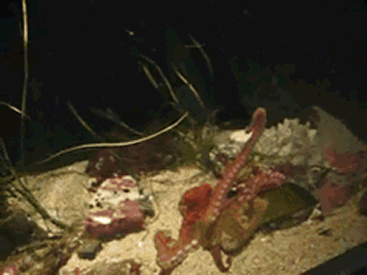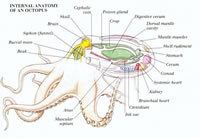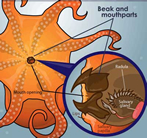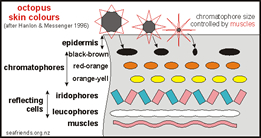General
Called the "Devil Fish" [4]
From Greek "eight footed". [2]
Member of the cephalopod class which means "head-foot". [12]
The Oxford English Dictionary lists octopuses, octopi and octopodes as the plurals of octopus. (in that order) [22]
The most complex brain/nervous system/eyes of any invertebrate.
200-300 octopus species. [2]
Highly intelligent, possibly more so than any other order of invertebrates. [2]
Short life expectancy. Some species live for as little as 6 months. Larger species may live for up to 5 years. [2]
They live longer the colder the water.
They live longer without their sex organs.
Octopuses were called dumb by Aristotle.
The oldest known octopus fossil is pohlsepia, which lived 296 million years ago.
Behavior
They tend to be nocturnal.
The Mimic octopus moves their arms in ways that emulate the shape and movements of other sea creatures. [2]
The Mimic Octopus can impersonate up to 15 marine species, including Sea Snakes, Stingrays, Lionfishes, and Jellyfishes.
It can morph into a flatfish, several sea snakes, and a lionfish by changing color, and altering the texture of its skin [17]
As intelligent as a house cat or 3 year old child.
The suction cups are equipped with chemoreceptors so the octopus can taste what it is touching. [2]
A 50-pound octopus can squeeze through a hole only 2 inches in diameter. [1]
They are often cannibalistic. [10]
Self cannibalism - eat own arms - due to a virus.
They have been reported to practice observational learning. [2]
The only invertebrate which has been shown to use tools. [2]
Camouflage is aided by specialized skin cells which can change the color, opacity, and reflectivity of the skin. [2]
Chromatophores contain yellow, orange, red, brown, or black pigments. [2]
Other color-changing cells are reflective iridophores, and leucophores. [2] [see pic below]
The color-changing ability can also be used to communicate with or warn other octopuses. [2]
An octopus can change color in less than a second.
Uses muscles in the skin to change the texture of their mantle to achieve a greater camouflage. [2]
Some aquariums use astroturf around the tank to prevent escape. They can't grip it.
Will not try to escape out a home smaller than the space between the eyes.
Can remember the way out of a maze.
One sucker on one of their tentacles can hold on to weights up to 35 pounds. [4]
The arms can break through plexiglass and take on a shark. [6]
Octopus dexterity is a thing of awe. One veterinarian saw an octopus undo its own surgical sutures. [12]
Octopuses even learned to open the childproof caps on Extra Strength Tylenol pill bottles. [17]
An octopus named Rambo can press the red shutter button on a waterproofed camera to take photos of visitors. [18]
Octopuses on ecstasy react a lot like humans do. [21]
They don't know where it's tentacles are, so they can't form a mental image of the shape of the object it is handling.
One octopus killed herself by pulling out her drain plug overnight. She couldn't tolerate the boredom of her aquarium.
One escaped captivity by climbing out of his tank and then down a drain.
One got bored in the winter when the aquarium was closed, and would juggle hermit crabs and throw rocks at the glass.
One dismantled a water recycling valve in his tank, releasing 200 gallons of water into the surrounding exhibits.
One in England would soak visitors and employees every time they passed his tank by squirting water at them.
An octopus once got so annoyed about the light above his tank that he squirted water at the bulb to short it out. [19]
Such is their intelligence that in many countries it is illegal to perform surgery on an octopus without anaesthetic.
Biology
They are about 90 percent muscle. [1]
An Octopus doesn't have 8 arms but 6 arms and 2 legs.
The beak, similar in shape to a parrot's beak, and made of chitin. [2]
The bloods blue color comes from hemocyanin, the copper-containing protein that binds oxygen. [3]
The copper is normally less efficient than iron, which helps explain the animal's sometimes apparent laziness. [3]
The giant can have a 30 foot arm span and can reach 600 lbs. [2]
Up to 200 suckers per arm. [4]
Each sucker has up to 10,000 neurons, 500 million in it's whole body. [3][20]
The suckers can taste as well as determine size and texture. [15]
They have 3 hearts. Two hearts pump blood to the gills, while a third circulates it to the rest of the body. [1]
There is no blind spot and almost no other retinal cells within the eye, and has no cornea. [11]
Octopuses appear to have limited hearing. [2]
Most cephalopods are completely color blind but are able to detect polarized light. [7]
Changes eye focus by moving the entire lens closer or further from the retina.
Always keeps its slit-shaped pupils in a horizontal position.
They have 9 brains. A central brain and a large ganglion at the base of each arm which controls movement. [1]
Scientists tested this by severing the nerves in the arms, then tickling them, responding as if attached. [3]
Grows at a rapid rate, increasing it's weight by 5 percent each day. [3]
By the end of its life, an octopus will weigh one-third as much as all the food it has eaten. [3]
A female pillow octopus is 40,000 times heavier than a male pillow octopus. [3]
An octopus feels like the inside of your cheek. An octopus is actually not slimy.
The mantle is a muscular structure that contains all of its organs. [5]
The skin can see. (Sense light.) [13][17]
Octopuses have one dominant eye like humans have a dominant hand [17]
Three-fifths of an octopus's neurons are not in the brain; they're in its arms. [17]
They have eyelids. [17]
They have fifty to seventy-five brain lobes, depending on how you count them. We have 4. [18]
An Octopus with 96 tentacles was caught in Japan in 2008.
Approximately two-thirds of an octopus's 500 million neurons cells reside in its tentacles instead of its brain.
The largest octopus ever found weighed 271kg and was 9m across.
Octopuses can survive one hour out of water.
They can get high on Ecstasy.
Like a starfish, an octopus can regrow lost arms. [23].
"Hectocotylus" is known as the 7 arm octopus because one arm is coiled in a sac beneath its right eye. [24].
Defense
Predators are sea otters, sharks, larger fish, seals, and sea lions. [9]
Bites the animal with its parrot-like beak, which injects a paralyzing poison. [9]
The darkest part of the beak is stronger then steel.
Ejects a thick, blackish ink in a large cloud to aid in escaping from predators. [2]
May reduce the efficiency of olfactory organs. [2]
Ink expelled from ink sac [sepia] near anus.
Melanin causes the ink color.
Can perform arm autonomy. The crawling arm serves as a distraction to would-be predators, and grows back. [2]
If the detached arm meets a food item, it seizes it and tries to pass it to where the mouth would be if still connected. [17]
Large octopuses have also been known to catch and kill some species of sharks. [2]
Australia's blue-ringed octopus, one of the most poisonous marine animals, has a venom deadly to humans. [1]
The moray eel is the most common enemy.
The blanket octopus can rip a tentacle from a Portuguese man-o-war and wield it like a sword to ward off enemies. [12]
The vampire squid can defend itself by biting off its own arm tip which floats off, luring away the enemy. [12]
To break the hold of the suckers of the much smaller common octopus would require a quarter ton of force [17]
The ink is physically harmful - it causes a blinding irritation. Octopi who do not escape their own ink cloud can die.
Reproduction
Mate late winter/spring.
Of the 100,000 eggs that hatch, only two, on average, survive to become adults. [4]
The tiny hatchlings are just over a quarter-inch long and weigh 22 milligrams. [16]
On day one, their eight little arms already have about 14 tiny suckers each. [16]
The Female octopus can wait until months after mating to fertilize the eggs. [1]
A sperm packet is inserted into the female's mantle cavity with their hectocotylus (3rd arm on the right).
Males can only live for a few months after mating. [2]
May take off the arm, storing it in her mantle until she lays her eggs, spreading the sperm to fertilize them. [3]
Sits on eggs and broods them for 2-10 months, forgoing food the entire time. [3]
She waves her arms over the eggs to prevent settling.
She also uses her siphon to spray the eggs clean, protecting them from predators. [3]
Lays clusters of eggs and attaches them in clusters to the ceiling of her lair. [8]
A deep sea octopus has been observed brooding her eggs for 4.5 years. [13]
The Striped Octopuses grasp each other's arms sucker-to-sucker and mate beak-to-beak, as if kissing. [14]
Day Octopus females will sometimes eat their male partners after mating, and eventually lay 600,000 eggs.
Octopuses die after mating and laying eggs, but first they go senile, acting like a person with dementia [17]
Locomotion
They swim by expelling a jet of water from a contractile mantle, and aiming it via a muscular siphon. [2]
The siphon propels the octopus in the opposite direction at speeds of up to 25 mph. [3]
Some can walk on two arms. [2]
Diet
Eats small pieces of food to avoid brain damage due to the esophagus going through it.
They usually inject their prey with paralyzing saliva before dismembering it into small pieces with their beaks. [2]
They eat mollusks, crustaceans, worms, fish and other cephlapods. [2]
Can use its beak to drill through shells and inject enzymes to dissolve the tissue inside. [9]
Will eat its own arms if it gets really hungry.
The Striped Octopus taps its prey on the shoulder and startles it into its arms. [14]
The octopus discards the shell into a rubbish pile, called a midden, just outside its den. [16]
Misc
Fishermen like to cut off the tip of an octopus arm and use it for halibut bait because wiggles even after being cut off. [1]
nationalpost.com
Wikipedia
How Octopuses Work
ABC news: Mystery of the Sea
Octopus organs
Octopus anatomy
Cephalopod Vision
Seasons in the Sea - Jan-Feb
Seasons in the Sea - May
Seasons in the Sea - Sept
NCBI
Ocean.si.edu
Science Daily
Science Daily
8 (or More) Reasons to be Amazed by the Octopus
Giant Pacific octopus
Deep Intellect
Popular Science
Against the Octopus
The Mind of an Octopus
Octopuses on ecstasy react a lot like humans do
What is the correct plural of octopus?
How Octopus Arms Regenerate With Ease
The seven arm octoupus
Here's some stories...
Contact:
polaro@hotmail.com
www.websitesforyou.net 





